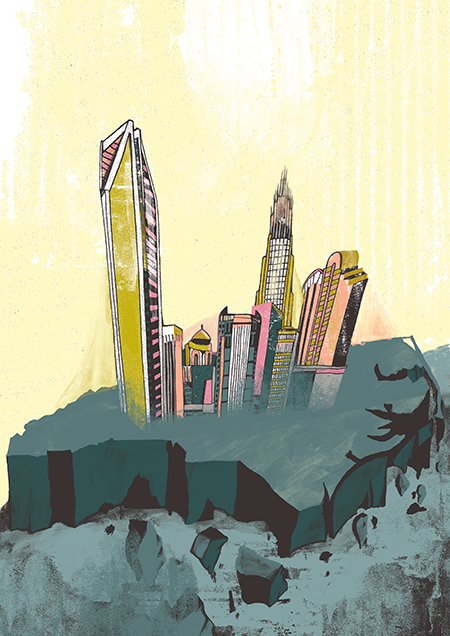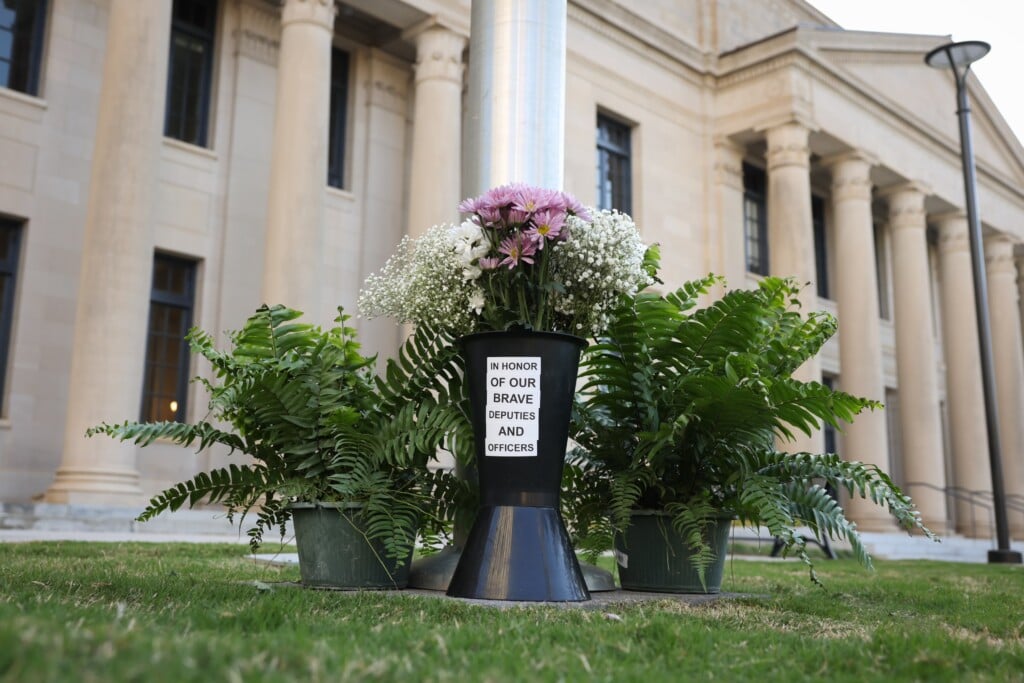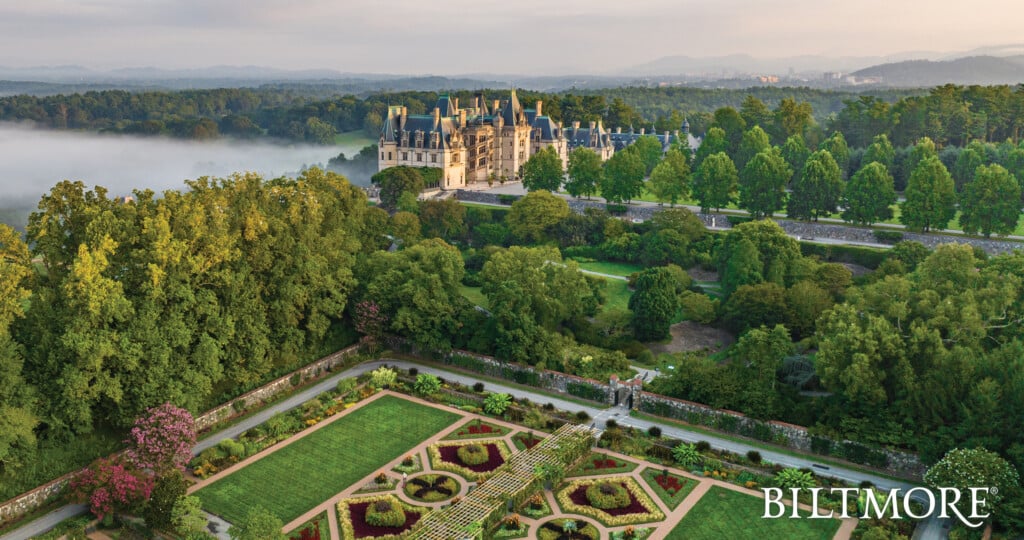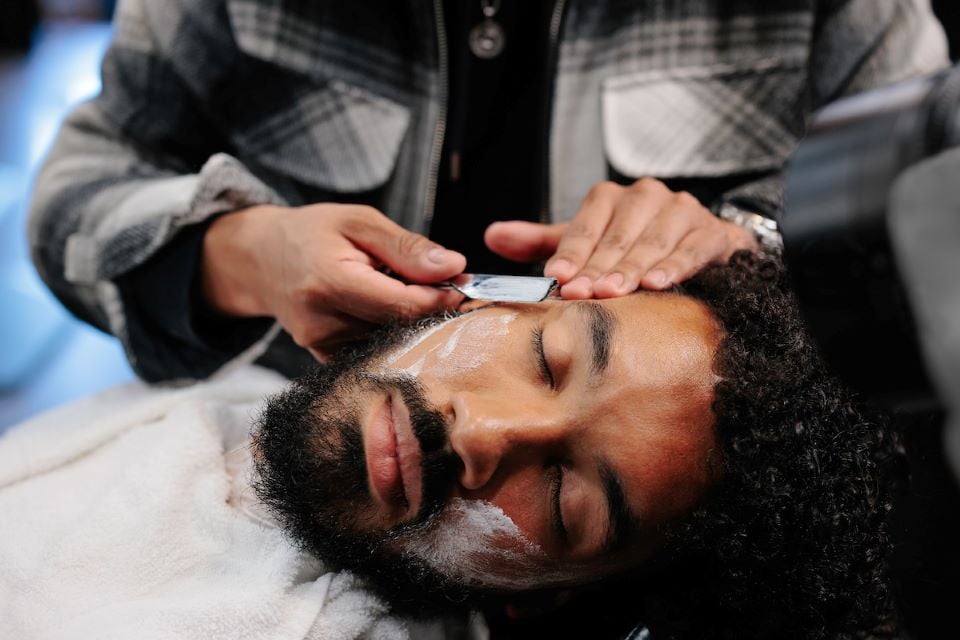2016: The Year Charlotte Lost
Going back to when the city passed liquor-by-the-drink in 1978, Charlotte has sped away from the communities that surround it. In 2016, though, the great urban-rural divide dominated the national conversation. Charlotte lost business, control of its destiny, and a sense of self, in part because of how quickly and thoroughly it had gone forward. Can—and should—it go back?

THE SCENE WOULD have gladdened the heart of any modern-day urban planner, or anyone who champions cities as the vanguard of 21st-century American life. It was a cool autumn morning in uptown’s First Ward Park, opened less than a year earlier thanks to a mix of public and private land and money. The people gathered were shepherding parks like this and other projects to create the model of a growing, vibrant, modern city: Anthony Foxx, a black man, a former mayor, and current U.S. Secretary of Transportation; Jennifer Roberts, a white woman, Charlotte’s third female mayor; Vi Lyles, a black woman, the highest-ranking City Council member.
The occasion on this October morning was a news conference to accompany Foxx’s tour of Charlotte’s transportation system “to highlight the economic progress that Charlotte and the nation have made, and the economic challenges that remain,” a Transportation Department release read. Shaun Donovan, the Obama Administration’s budget director, joined them. The Bank of America and Hearst towers soared behind them into a clear sky. The scene belied the reality that 2016 had been one of the most trying years in Charlotte’s history, with House Bill 2 costing the city hundreds of millions of dollars and more than 1,000 jobs, and violent protests in uptown over the Keith Scott shooting a little more than a month before.
But Foxx, named to Obama’s cabinet in spring 2013, told the small group of assembled reporters how good it was to be home, and how proud he was to have played a role in the city’s two light rail lines: the north-south Blue Line—an extension set to open this year runs, appropriately, next to the park—and the first of three legs of the Gold Line streetcar traversing part of uptown four blocks away.
“We didn’t know if we’d get one project done. But we got two projects started, and I’m looking forward to seeing more progress,” Foxx said.
The Gold Line was conceived as a way to eventually link the city center with poor, minority neighborhoods on the east and west sides and boost economic development there. It’s also designed to fulfill another touchstone of modern urban planning, rail projects as alternatives to roads. It was a deeply contentious project funded and built in the aftermath of a recession. “The fact that this project has actually happened,” Foxx said, “is a minor miracle given the economic conditions we faced at the time.”
Donovan talked mostly about Charlotte as an example of federal investment in cities’ large-scale projects as a vehicle for rejuvenating their economies. As he and Foxx spoke, it grew clearer that their message, coming two weeks before the presidential election, was at least as much subtext as text. Look at what a cooperative federal government can do for cities and their people, they seemed to say. Don’t you want to keep going down the path we’re on?
Two weeks later, Mecklenburg County voters decided they did, by a nearly two-to-one margin. North Carolina voters decided they didn’t—by nearly four percentage points in a race projected as a toss-up. Voters in a majority of U.S. states didn’t, either. Three days after the election, President-elect Donald Trump named as the transportation and infrastructure adviser to his transition team someone with no apparent affection for the development of light rail in cities: a high-profile Washington lobbyist, Martin Whitmer, whose roster of clients includes the National Asphalt Pavement Association.
***
IT’S A CLICHÉ to refer to the United States as a “divided nation.” Now, after an election that ran nearly dead down the center of urban and non-urban America, “divided” seems too weak a word. Cities are, broadly, racially diverse, progressive, service industry-oriented, near-exclusive holders of cultural and entertainment options, welcoming if not embracing of LGBT citizens, users of mass transit, and Democratic. Rural, small-town, and exurban areas are generally white, conservative, Republican, barely tolerant if not hostile to LGBT citizens, and dependent on personal vehicles and a robust manufacturing sector that, due to globalization, no longer exists. Economically, culturally, and increasingly, the world the nation’s city-dwellers inhabit and the one rural, small-town, and exurban residents live in are not just separated but alien and incomprehensible to each other, despite anyone’s post-election yearning to “bridge the divide” between the two.
The electoral map from November reflects the alienation with unsettling clarity, and while it’s hardly news that the divide has existed for years, its width and depth grow with each election cycle. In the 2016 election, Democrat Hillary Clinton won nearly 90 percent of “urban core” counties “while Trump won the vast majority—between 75 and 90 percent—of suburbs, small cities and rural areas,” according to a Washington Post analysis the day after the election.
Charlotte stands firmly on the urban side. The gap between the city and its neighbors, once a ditch, has grown into a chasm that took nearly 40 years to dig. In many ways, 2016 was a year when Charlotte, in a reversal of decades of gain, lost things: coveted business; some control of its own destiny; its own sense as a peaceful and progressive place destined to move constantly forward. In 2016, large reactionary forces in American society threw lines of tire spikes across the road, as they did for cities throughout the country. Charlotteans have suffered, and will suffer, because of it.
So, the dilemma: Do we go back, try to narrow the gap, and risk the progress the city has made? Or do we keep moving forward and out of sight?
***
I CALLED ROSALIA TORRES-WEINER the morning after the election. The longtime Charlotte painter and native of Mexico was, oddly enough, in Washington, D.C., at the Smithsonian Anacostia Community Museum, about a 20-minute drive from the White House. The museum had invited her to paint a mural as part of a new exhibit, “Gateways,” on “the triumphs and struggles of Latino migrants and immigrants” in four American cities, including Charlotte. Torres-Weiner had painted for six straight days—with one more, that Wednesday, to go.
On those first five mornings in Washington, Torres-Weiner had arrived at the Anacostia before 9 a.m., well before opening, ready to throw on her painting clothes, prepare her brushes, and get to work. This morning was different.
“I’m sitting in front of my mural, and I’m just trying to find the motivation to finish it,” she told me. “I grabbed a chair, which I never do, and I just sat in front of the mural, because today is my last day at the museum, and I couldn’t help thinking, ‘Was this worth it?’”
Now 54, she moved to Charlotte in 1996, a little more than a decade after she left Mexico City for Los Angeles. She wanted to learn English and began working as a flight attendant, at times indulging her childhood passion—discouraged by her parents—for drawing and painting. There, while working data entry for Sears, she met her husband, Ben Weiner, a younger Jewish man she married in 1994. Ben, now an adviser for a Charlotte technology firm, landed a job in Charlotte a year or two later. She joined a massive wave of Latino immigration into the city during the 1990s and 2000s, as tens of thousands relocated to Charlotte for work. Mecklenburg County’s Hispanic population rose from 6,693 and 1.3 percent of the county’s population in 1990 to 111,944 and 12.2 percent in 2010.
In Charlotte, Torres-Weiner still worked flight attendant jobs, but she lost the desire to spend too much time in the air after 9/11. She soon found she could earn a living by painting. Her murals, carnivals of vivid primary colors, adorn walls all over Charlotte—at Las Delicias Bakery on Central Avenue, at The Blind Pig bar in NoDa. In recent years, she’s rendered scenes that reflect her community’s struggles with deportation and U.S. immigration policy, including the ongoing 287(g) program in Mecklenburg County, which allows sheriff’s deputies to act as de facto federal immigration officers.
Torres-Weiner’s adopted city has embraced her and her work. The Levine Museum of the New South organized an exhibit and children’s education program based on a series of paintings she did about children dealing with deportation—including one young boy trying to reunite with his deported father. Children’s Theatre of Charlotte adapted her children’s book about deportation into a play, The Magic Kite, and staged it last year. Her invitation to paint at the Anacostia—part of the Smithsonian!—seemed to Torres-Weiner, an American citizen since 1995, like an even higher validation of her citizenship by her adopted homeland.
And on Wednesday, November 9, she woke up to learn that her adopted homeland had elected as President someone who had campaigned on deporting millions of people like her and building a “wall” to keep them out, someone who kicked off his campaign by referring to Mexican immigrants as criminals and rapists.
“A lot of people in my community are scared, are frightened, like we’re going several steps back,” she told me over the phone. “I thought we were going forward, and I’m just very disappointed. All of these people, they came to this country because they believed in democracy, believed in opportunity, believed in hope. And now it’s the opposite. People are scared. My daughter called me this morning, and, you know …” Torres-Weiner trailed off and began to choke up. “What can I tell her?”
***
DEEP CHANGE TAKES DECADES or longer. It’s silly and reductionist to point to one or a handful of events that cleaved Charlotte from the rest of North Carolina. But you can find some distinct turning points.
One came in September 1978, when Mecklenburg County voters approved liquor-by-the-drink—a decision that paved the way for the city’s boom as a financial services center. The textile industry had collapsed; Charlotte’s last mill had closed three years before. Business had deserted the city center for the suburbs. Charlotte business leaders saw a future unavailable to them unless they could court it over cocktails. They saw liquor-by-the-drink as a pathway to bars opening, investment from Northern business interests, and a rebirth of Charlotte as a cosmopolitan, New Southern city.
They were right. Charlotte’s population more than doubled from 1980 to 2010. In that campaign, the signs of a coming split, and all it entailed, were already evident. When the measure passed, a Baptist minister and prominent Kannapolis politician—a representative of the same evangelical, conservative, working-class bloc that would figure so prominently in the 2016 election—made a clear and disapproving distinction between what Charlotte had been and what it was becoming.
“I’m convinced,” said Coy Privette, the minister and politician, “people want Charlotte to be another Atlanta or New York.”
The rejuvenation of the city center turned out to have a side effect that wasn’t evident until much later. The protests and violence that followed the September police shooting of Keith Scott revealed another long-ignored division within the city, between the affluent and mostly white occupants of the urban core and the mostly poor and minority residents shunted into east and west side neighborhoods. “For the people we serve,” the Reverend Peter Wherry of Mayfield Memorial Missionary Baptist Church told The Associated Press a few days after the shooting, “the Queen City is only the Queen City if you get on the train and ride into the glimmering, crystal core.”
Another pivotal date: 2012, when the U.S. Census Bureau determined that Mecklenburg County, 72 percent white as recently as 1980, now had more non-white than white residents.
A third: March 23, 2016, when the North Carolina General Assembly passed House Bill 2.
***
IN THE FIRST FEW DAYS after the governor signed HB2, Nicole Scher fielded dozens of calls from subcontractors, people counting on work during upcoming sporting events in Charlotte, Greensboro, and Raleigh. She’s the co-owner of ScherShot Productions, a video production company that shoots and edits footage from sporting events for college sports leagues and venues. To every one of the people calling her, she had to deliver the hard reality.
“We were frustrated, angry. They all were calling me: ‘Are we still going to be doing that event?’ ‘Well, not locally, no, and because it costs so much to move all that gear, we probably won’t do that, either.’ And it trickles all the way down to the concession stand workers. Those people are teachers, people who need that extra income—and now it’s gone.
“So thank you, state and city. You have increased our poverty level and caused a lot of chaos that didn’t need to be.”
For the record, she blames both Charlotte city officials for passing non-discrimination protections for LGBT citizens and the legislature for passing HB2 in response. They’re both “bullheaded,” she says, politicians who don’t care about working people. “They’re just trying to make a name for themselves and not doing it the right way,” she told me in mid-November.
Scher believes the issue should have been put to a countywide vote.
Scher, 36, grew up in Charlotte. Her father, Carl, founded ScherShot in 1987, and the company built a clientele over the next three decades. At the beginning of 2016, Nicole Scher, now a co-owner, expected ScherShot to earn a few hundred thousand dollars from its contracts with Charlotte’s Spectrum Center and Greensboro Coliseum, a longtime client, to work during the NBA All-Star Game and planned NCAA and ACC basketball and football games.
That was until summer, when the NBA, ACC, and NCAA all pulled events out of North Carolina because of HB2.
“We had quite a few things lined up before HB2. I’d say we lost one week in Charlotte, immediately. Some of our contractors lost five days of work,” she told me. “In Greensboro, we lost four weeks of work. We lost—what else have we lost?—actually, I’m lying to you: We lost six weeks in Greensboro, two weeks in Raleigh. About 40 people in Charlotte and Greensboro don’t have any work for those weeks. That’s a lot of money for them. … For small business, 14 weeks of billable hours for 40 people. … I mean, rough estimate, about $200,000.”
ScherShot has found other work out of state to fill the gaps in its annual income. But that leaves local subcontractors out of work and luck. Chambers of Commerce throughout the state and business consultants throughout the country have strained muscles trying to estimate just how much business North Carolina has lost because of HB2. But even the best guesses are just that, guesses. They don’t account for potential investments abandoned or not even considered, known only to those who made those decisions. The only things anyone can say for certain: The economic damage is real and just beginning, and it primarily hurts North Carolina’s cities.
“We’re OK right now,” Scher said. “But I don’t know where we’ll be five years from now, or a year from now, when more things don’t come here. We’ll have to adjust to that.
“It’s frustrating, and it’s infuriating to see nothing happening. It’s like they don’t care, and that goes for local and state. We will make the adjustments needed. If it means moving, OK. I mean, it depends on what the politicians do. … We’ll have to see. I’m hopeful. But I am not optimistic.”
***
AS WE CONTINUED to talk that Wednesday after the election, Torres-Weiner’s mood gradually changed. She had started the conversation dazed, numb, muttering. As she kept talking about how she felt about the election and result, her enunciation grew stronger, more suffused with the spirit I’m accustomed to hearing from her. It was as if she was giving herself a pep talk. She referred to “fighting with my brushes for the next four years,” and how she just needed to get bigger brushes. Then she laughed.
“I know my community, my Latino community, has been very strong and resilient. We just have to find that resiliency and passion to keep fighting for four more years,” she said. “We’re not going to let anybody make us feel that we lost, you know. It’s sad right now, this moment. I’m disappointed, scared, all those mixed feelings. But we know that we have done it, and we need to get out and do it with ganas, more fuerza.” Words that mean, roughly, “resolution.”
“It’s a nightmare, a pesadilla.” I got the distinct impression she was talking less to me than to herself. “But like a pesadilla, it will pass. We can make it. We can make it. We can make it.”
“Ganas,” she said with finality, saying she needed to get back to work. “I have to finish this mural today.” The next morning, on Facebook, she posted a photo of her finished work and another of the Washington Monument, and announced that she was on her way back home to Charlotte.
Greg Lacour is a contributing editor to this magazine. Read more of his work in the Buzz section of www.charlottemagazine.com.







